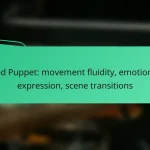How to master puppet performance techniques?
Mastering puppet performance techniques involves honing specific skills that enhance the overall presentation. Key areas include manipulation skills, voice modulation, character development, and stage presence, each contributing to a captivating performance.
Manipulation skills
Manipulation skills are fundamental for any puppeteer, as they determine how effectively a puppet can be animated. This includes mastering the mechanics of the puppet, such as controlling its movements and expressions with precision. Practicing basic movements like walking, jumping, or turning can help build a strong foundation.
Consider using a mirror to observe your puppet’s movements from different angles. This practice allows you to refine your technique and ensure that the puppet’s actions appear natural and engaging. Regular rehearsal will help develop muscle memory, making manipulation feel instinctive.
Voice modulation
Voice modulation is crucial for bringing a puppet to life and making it relatable to the audience. Varying pitch, tone, and speed can create distinct voices for different characters, enhancing their individuality. Experiment with different vocal styles to find what best fits each puppet’s personality.
When performing, practice projecting your voice without straining. Use breathing techniques to maintain control and clarity. Recording your practice sessions can provide valuable feedback on your voice modulation, helping you identify areas for improvement.
Character development
Character development involves creating a backstory and personality for each puppet, making them more engaging for the audience. Consider their motivations, quirks, and relationships with other characters. This depth adds richness to the performance and helps the audience connect emotionally.
To develop a character, write a brief profile that includes their traits and history. Role-playing can also be beneficial; act out scenarios to explore how your puppet would react in different situations. This practice can lead to more authentic performances.
Stage presence
Stage presence is about commanding attention and engaging the audience through confidence and charisma. A puppeteer should embody their character fully, using body language and facial expressions to enhance the performance. Strong stage presence can make even simple actions captivating.
To improve stage presence, practice performing in front of a mirror or record yourself to analyze your movements and expressions. Pay attention to your posture and eye contact, as these elements significantly impact how the audience perceives your performance. Engaging with the audience through direct interaction can also enhance your stage presence.
What are the best puppet types for performances in Australia?
The best puppet types for performances in Australia include marionettes, hand puppets, and shadow puppets. Each type offers unique characteristics and advantages that cater to different performance styles and audience engagement.
Marionettes
Marionettes are puppets controlled by strings, allowing for intricate movements and expressions. They can be quite elaborate, often requiring a skilled puppeteer to manipulate them effectively. In Australia, marionettes are popular for theatrical performances due to their ability to convey complex narratives.
When using marionettes, consider the space needed for string manipulation and the audience’s viewing angle. A well-crafted marionette can range from a few hundred to several thousand Australian dollars, depending on the craftsmanship and materials used.
Hand puppets
Hand puppets are operated by the puppeteer’s hand, making them highly interactive and engaging for audiences, especially children. They are typically simpler in design compared to marionettes and can be made from various materials, including fabric and foam.
In Australia, hand puppets are often used in educational settings and children’s shows. They are relatively affordable, with prices ranging from AUD 20 to AUD 200, making them accessible for schools and community groups. Ensure that the puppets are durable and easy to clean, as they may be used frequently.
Shadow puppets
Shadow puppets create visual storytelling through silhouettes cast on a screen, making them a captivating form of performance art. This technique relies on light sources and the manipulation of flat figures to create movement and narrative.
In Australia, shadow puppetry can be a unique addition to cultural festivals and workshops. The setup requires a light source, a screen, and the puppets themselves, which can be crafted from cardboard or other materials. This form of puppetry is cost-effective, often requiring minimal investment, making it an excellent choice for community events and educational purposes.
How to choose the right puppetry style for your audience?
Selecting the appropriate puppetry style for your audience involves understanding their preferences, age, and the context of the performance. Different styles resonate with different demographics, so consider these factors carefully to enhance engagement and enjoyment.
Target age group
The target age group significantly influences the choice of puppetry style. For younger children, bright, colorful puppets with simple stories work best, while older children and adults may appreciate more complex narratives and sophisticated puppetry techniques. Tailoring your performance to the age group ensures that the content is relatable and captivating.
For example, marionettes and shadow puppets may appeal more to teens and adults, while hand puppets and finger puppets are often favored by preschoolers. Understanding the developmental stages of your audience can guide your selection.
Theme relevance
The theme of your performance should align with the interests and values of your audience. Consider what themes resonate with them, whether it’s adventure, friendship, or cultural stories. A relevant theme can enhance emotional connection and engagement.
For instance, if performing for a school audience, themes related to friendship and teamwork can be effective. In contrast, a performance for a corporate event might benefit from themes of innovation or collaboration.
Performance setting
The setting of your performance plays a crucial role in determining the puppetry style. Indoor settings may allow for more intricate puppetry techniques, while outdoor performances may require simpler, more robust designs that can withstand environmental factors.
Additionally, consider the audience size and layout. A small, intimate setting might suit close-up puppetry styles, while larger venues may require larger puppets or more dynamic performances to reach the back rows effectively. Always adapt your style to fit the venue for maximum impact.
What are the key elements of a successful puppet show?
A successful puppet show hinges on three key elements: an engaging storyline, visual appeal, and audience interaction. These components work together to create an immersive experience that captivates viewers and keeps them coming back for more.
Engaging storyline
An engaging storyline is the backbone of any puppet show. It should be simple yet compelling, allowing audiences to easily follow the plot while being invested in the characters’ journeys. Consider themes that resonate universally, such as friendship, adventure, or overcoming challenges.
To enhance the storyline, incorporate relatable characters and unexpected twists. For example, a tale of a lost puppet finding its way home can evoke empathy and excitement, making the audience root for the protagonist.
Visual appeal
Visual appeal is crucial in puppet performance, as it captures the audience’s attention and enhances storytelling. Use vibrant colors, intricate designs, and varied puppet types to create a visually stimulating environment. The puppets should be expressive, allowing for a wide range of emotions to be conveyed.
Lighting and stage design also play significant roles. Consider using soft, warm lighting to create an inviting atmosphere or dramatic effects to highlight key moments. A well-designed backdrop can transport the audience into the world of the story, making it more immersive.
Audience interaction
Audience interaction elevates a puppet show by making viewers feel involved in the performance. This can be achieved through direct engagement, such as asking questions or inviting audience members to participate in the story. Such interactions can create memorable moments and foster a sense of connection.
Be mindful of the audience’s age and preferences when planning interactions. For younger viewers, simple prompts or actions can be effective, while older audiences may appreciate more complex engagement. Balancing interaction with the flow of the show is key to maintaining the overall experience.
What are the costs associated with puppet performances in Australia?
The costs of puppet performances in Australia can vary widely based on several factors, including the type of puppets used, the scale of the production, and the venue. Generally, you can expect expenses to range from a few hundred to several thousand Australian dollars.
Materials and puppets
The materials and puppets used in a performance significantly influence the overall cost. Basic puppets made from fabric and foam may cost around AUD 50 to AUD 200 each, while more intricate designs, such as marionettes or animatronics, can range from AUD 500 to AUD 2,000 or more.
When selecting materials, consider durability and visual appeal. Common materials include wood, plastic, and textiles, each offering different aesthetic qualities and price points. Investing in high-quality materials can enhance the performance but will increase initial costs.
Additionally, if you plan to create custom puppets, factor in the costs of design and labor. Hiring a skilled puppeteer or designer can add several hundred dollars to your budget, but their expertise can elevate the performance quality significantly.















